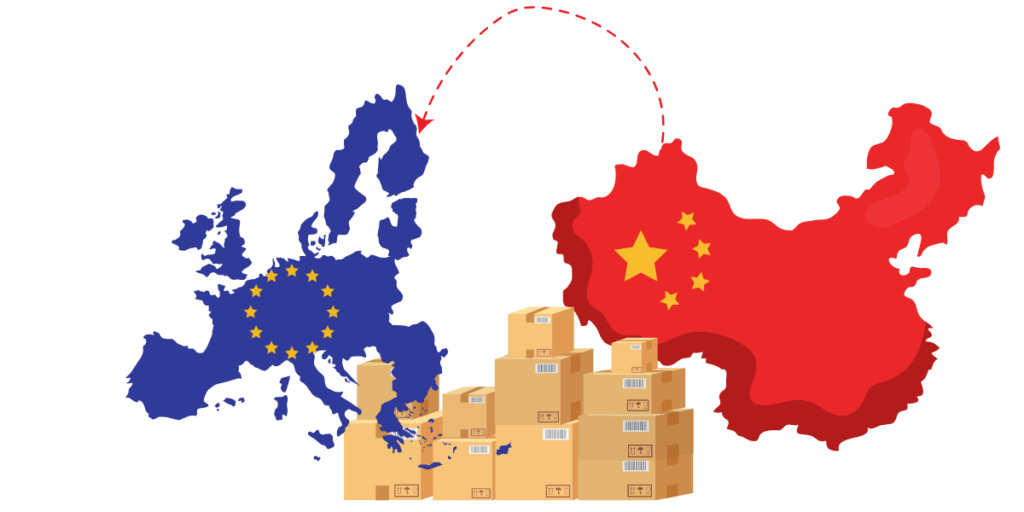- By TOP CHINA FREIGHT
- October 11, 2025
- Shipping
Table of Contents
What documents needed for textiles from China to Europe is the first thing every importer should understand before shipping. When shipping textiles internationally, documentation is your passport to smooth customs clearance. Knowing the right paperwork ensures your fabrics, garments, or industrial materials move efficiently through ports, inspections, and EU compliance checks. This comprehensive guide explains the key documents, logistics steps, and expert techniques to simplify your textile import process from start to finish.

Why Documentation Matters in Textile Shipping
Importing textiles involves multiple inspection stages and compliance layers—especially when goods move from China’s manufacturing hubs to European Union markets. Each document acts as proof of origin, quality, and conformity with regulations such as REACH, OEKO-TEX, and EU customs law.
Without proper documentation, even high-value shipments risk long delays or additional tariffs.
Key benefits of proper documentation include:
- Faster customs clearance
- Accurate tariff classification and lower duty exposure
- Protection against disputes over product quality or origin
- Compliance with textile labeling and safety standards
What Are the Essential Shipping Documents for Textiles?
The following table summarizes the primary paperwork required when exporting textiles from China to Europe:
| Document Name | Purpose | Issued By | Notes |
|---|---|---|---|
| Commercial Invoice | Declares product details, value, and trade terms | Exporter | Must match packing list and Incoterms |
| Packing List | Lists package count, weight, dimensions | Exporter | Used for inspection and unloading |
| Bill of Lading / Air Waybill | Proof of shipment | Shipping carrier | Original needed for cargo release |
| Certificate of Origin (Form A or RCEP) | Confirms country of manufacture | Chinese Chamber of Commerce | May qualify for tariff reductions |
| Textile Composition Report | Confirms fiber content and material blend | Manufacturer / Lab | Required for customs classification |
| REACH Compliance Declaration | Confirms chemical safety compliance | Exporter / Lab | Mandatory for EU market |
| Insurance Certificate | Proof of cargo coverage | Insurer | Optional but highly recommended |
| Import License (for restricted categories) | Authorizes import of controlled goods | EU importer | May apply to certain fabrics or dyes |
How to Prepare Each Document Correctly
1.Commercial Invoice
Ensure every detail aligns with Incoterms (FOB, CIF, DDP). Include:
- Exporter and importer details
- HS codes and fabric descriptions
- Quantity, unit price, and total value
- Country of origin
2. Certificate of Origin
A Form A or RCEP Certificate helps reduce tariffs under trade agreements. Double-check that:
- The exporter’s stamp is original.
- The date matches the shipping documents.
- Fabric type and HS codes correspond correctly.
3. Packing List
Customs officers often use the packing list to confirm declared weights and volumes.
Tip: Use consistent units (kg, cm) and clearly mark carton numbers.
4. REACH Declaration
REACH (Registration, Evaluation, Authorisation, and Restriction of Chemicals) is vital for textiles containing dyes or coatings.
Attach laboratory test results for restricted substances such as AZO dyes, formaldehyde, or heavy metals.
Do Different Textile Types Need Different Documents?

Yes. Each textile category may trigger specific documentation requirements:
| Category | Additional Documents | Compliance Focus |
|---|---|---|
| Garments & Apparel | Labeling compliance certificate | Fiber content and washing instruction accuracy |
| Home Textiles | Fire-retardant certification | Safety standards (EN 13772, EN 1102) |
| Industrial Fabrics | Technical performance report | Tensile strength, permeability, coating adherence |
| Yarns & Threads | Fiber composition declaration | Chemical safety and traceability |
What Are the Common Shipping Methods for Textiles?
Depending on order volume and urgency, choose between air, sea, or rail freight.
| Mode | Transit Time (China → Europe) | Average Cost (per CBM) | Best For | Pros | Cons |
|---|---|---|---|---|---|
| Sea Freight (FCL/LCL) | 30–40 days | $60–$120 | Bulk fabric rolls | Cost-effective, reliable | Long transit time |
| Rail Freight | 18–22 days | $150–$250 | Medium volume textile loads | Balanced cost and speed | Limited to central EU destinations |
| Air Freight | 5–10 days | $600–$900 | Fashion samples or urgent orders | Fast, secure | Expensive for heavy cargo |
Pro tip: Consolidate shipments into LCL (Less than Container Load) to optimize cost without delaying smaller orders.
How to Ensure Compliance with EU Textile Regulations
European importers must meet strict product labeling and chemical safety standards. Ensure your Chinese supplier provides:
- Fiber composition declaration (percentage of materials)
- Washing symbols following ISO 3758
- Manufacturer identification tags
- Country of origin labels
Additionally, verify conformity with:
- REACH Regulation (EC 1907/2006)
- Textile Regulation (EU) No 1007/2011
Failure to comply can lead to product recalls or seizure at customs.
What Happens During Customs Clearance in Europe?
1.Document verification — Customs reviews invoice, packing list, and certificates.
2.Duty calculation — Based on HS code, country of origin, and declared value.
3.Inspection — Random quality or labeling checks.
4.Release authorization — Once duties are paid, the shipment proceeds to delivery.
To speed clearance:
- Pre-declare goods using electronic systems (like ICS2).
- Maintain identical data across all forms.
- Work with an experienced freight forwarder.
Common Mistakes Importers Should Avoid
Causes delays or higher duty rates.
Especially for dyed or printed fabrics.
Triggers customs red flags.
Leads to incomplete or fraudulent paperwork.
Case Study: Cotton Fabric Shipment from Guangzhou to France

A French textile company importing 15 tons of cotton fabric from Guangzhou opted for rail freight via Chongqing–Duisburg.
Key steps:
- Obtained a RCEP Certificate of Origin for tariff reduction (down 4.5%).
- Conducted REACH testing for azo dye compliance.
- Submitted pre-arrival documents electronically to French customs.
Result:
Delivery completed in 21 days, saving $1,200 compared to air freight while achieving faster clearance due to document accuracy.
Best Practices for Smooth Textile Shipping
- Prepare all documents simultaneously to avoid sequence delays.
- Digitize paperwork—many EU ports now prefer e-certificates.
- Maintain close contact with suppliers and forwarders.
- Verify REACH certificates annually, especially for seasonal fabric changes.
- Use Incoterms like DDP for simplified logistics management if your partner offers it.
Conclusion
Understanding what documents needed for textiles from China to Europe is the foundation of efficient textile trade. From invoices and certificates to REACH declarations, every form carries weight in ensuring compliance, cost-efficiency, and on-time delivery. As EU standards evolve, maintaining updated documentation practices safeguards your business from costly customs delays and regulatory penalties. Partnering with a knowledgeable China–Europe freight forwarder can transform complex textile logistics into a seamless process.
Need a Shipping Quote?
If you want expert guidance and peace of mind, our team is ready to assist.
TJ China Freight offers tailored solutions to help businesses of all sizes ship more reliably from China.

FAQ
Q1: Do I need a REACH certificate for all fabrics?
Yes, especially if textiles contain chemical dyes or coatings. REACH ensures the fabric is free from harmful substances restricted under EU law.
Q2: Can I ship small textile samples without full documentation?
Yes, small non-commercial samples can be declared under simplified customs procedures, though a proforma invoice and air waybill are still required.
Q3: How can I verify my Chinese supplier’s compliance?
Request their test reports, REACH certificates, and production audit records. A reliable freight forwarder can help validate authenticity before shipment.
Q4: What Incoterms are best for textile imports?
FOB (Free on Board) and CIF (Cost, Insurance, Freight) are most common. If you prefer hassle-free delivery, choose DDP (Delivered Duty Paid).
Q5: Are there import duties on Chinese textiles in Europe?
Yes, but rates vary based on fabric type and trade agreements. With a RCEP Certificate of Origin, you may benefit from reduced tariffs.



